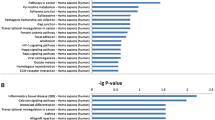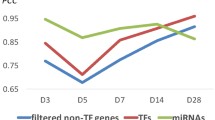Abstract
Hepatocyte Growth Factor (HGF) controls growth and differentiation in different cell types, including cardiac cells. However, its downstream effectors are poorly understood. To investigate the transcriptional targets of HGF, we analyzed the hearts of neonatal mice with cardiomyocyte-specific HGF overexpression with whole genome DNA microarrays. When comparing HGF expressing versus control hearts, we found a total of 249 transcripts with significant gene expression changes (210 upregulated and 39 downregulated). Gene Ontology (GO) annotation analysis revealed that the transcripts modulated by HGF were enriched for metabolic functions including: protein translation, vesicle-mediated transport, regulation of transcription, regulation of muscle development. Using an automated literature meta-analysis approach, we obtained a co-occurrence network oriented to the positive regulatory role of Myc and Notch1 in controlling some of the genes which are downstream to HGF. GO analysis of this network returned genes involved in the regulation of heart development. HGF positively controls MyocD, an activator of cardiac gene expression, and Hdac5, an inhibitor of cardiac growth. These results may unveil a new role of HGF in the modulation of signaling pathways implicated in the activation or repression of cardiomyogenesis.



Similar content being viewed by others
References
Andersson E, Bryjova L, Biris K, Yamaguchi TP, Arenas E, Bryja V (2010) Genetic interaction between Lrp6 and Wnt5a during mouse development. Dev Dynam 239:237–245
Bossuyt J, Helmstadter K, Wu X, Clements-Jewery H, Haworth RS, Avkiran M, Martin JL, Pogwizd SM, Bers DM (2008) Ca2+/calmodulin-dependent protein kinase II delta and protein kinase D overexpression reinforce the histone deacetylase 5 redistribution in heart failure. Circ Res 102:695–702
Boyle EI, Weng SA, Gollub J, Jin H, Botstein D, Cherry JM, Sherlock G (2004) GO:TermFinder—open source software for accessing Gene Ontology information and finding significantly enriched Gene Ontology terms associated with a list of genes. Bioinformatics 20:3710–3715
Cantarini MC, de la Monte SM, Pang MY, Tong M, D’Errico A, Trevisani F, Wands JR (2006) Aspartyl-asparagyl beta hydroxylase over-expression in human hepatoma is linked to activation of insulin-like growth factor and notch signaling mechanisms. Hepatology 44:446–457
Carmona-Saez P, Chagoyen M, Tirado F, Carazo JM, Pascual-Montano A (2007) GENECODIS: a web-based tool for finding significant concurrent annotations in gene lists. Genome Biol 8:R3
Chang JT, Nevins JR (2006) GATHER: a systems approach to interpreting genomic signatures. Bioinformatics 22:2926–2933
Chang SR, McKinsey TA, Zhang CL, Richardson JA, Hill JA, Olson EN (2004) Histone deacetylases 5 and 9 govern responsiveness of the heart to a subset of stress signals and play redundant roles in heart development. Mol Cell Biol 24:8467–8476
D’hoedt D, Owsianik G, Prenen J, Cuajungco MP, Grimm C, Heller S, Voets T, Nilius B (2008) Stimulus-specific modulation of the cation channel TRPV4 by PACSIN 3. J Biol Chem 283:6272–6280
Fu LM, Medico E (2007) FLAME, a novel fuzzy clustering method for the analysis of DNA microarray data. BMC Bioinformatics 8:3
Gallego MI, Bierie B, Hennighausen L (2003) Targeted expression of HGF/SF in mouse mammary epithelium leads to metastatic adenosquamous carcinomas through the activation of multiple signal transduction pathways. Oncogene 22:8498–8508
Gude NA, Emmanuel G, Wu WT, Cottage CT, Fischer K, Quijada P, Muraski JA, Alvarez R, Rubio M, Schaefer E, Sussman MA (2008) Activation of Notch-mediated protective signaling in the myocardium. Circ Res 102:1025–1035
Gudmundsson H, Hund TJ, Wright PJ, Kline CF, Snyder JS, Qian L, Koval OM, Cunha SR, George M, Rainey MA, Kashef FE, Dun W, Boyden PA, Anderson ME, Band H, Mohler PJ (2010) EH domain proteins regulate cardiac membrane protein targeting. Circ Res 107:84–95
Ha CH, Kim JY, Zhao JJ, Wang WY, Jhun BS, Wong C, Jin ZG (2010) PKA phosphorylates histone deacetylase 5 and prevents its nuclear export, leading to the inhibition of gene transcription and cardiomyocyte hypertrophy. Proc Natl Acad Sci USA 107:15467–15472
Hansson EM, Lindsay ME, Chien KR (2009) Regeneration next: toward heart stem cell therapeutics. Cell Stem Cell 5:364–377
Ho Sui SJ, Fulton DL, Arenillas DJ, Kwon AT, Wasserman WW (2007) oPOSSUM: integrated tools for analysis of regulatory motif over-representation. Nucleic Acid Res 35:W245–W252
Hong CS, Kwon SJ, Cho MC, Kwak YG, Ha KC, Hong BZ, Li HY, Chae SW, Chai OH, Song CH, Li YH, Kim JC, Woo SH, Lee SY, Lee CO, Kim DH (2008) Overexpression of junctate induces cardiac hypertrophy and arrhythmia via altered calcium handling. J Mol Cell Cardiol 44:672–682
Huang JH, Lu MM, Cheng L, Yuan LJ, Zhu XQ, Stout AL, Chen M, Li J, Parmacek MS (2009) Myocardin is required for cardiomyocyte survival and maintenance of heart function. Proc Natl Acad Sci USA 106:18734–18739
Kaposi-Novak P, Lee JS, Gomez-Quiroz L, Coulouarn C, Factor VM, Thorgeirsson SS (2006) Met-regulated expression signature defines a subset of human hepatocellular carcinomas with poor prognosis and aggressive phenotype. J Clin Invest 116:1582–1595
Kitano H (2002) Computational systems biology. Nature 420:206–210
Kwon C, Qian L, Cheng P, Nigam V, Arnold J, Srivastava D (2009) A regulatory pathway involving Notch1/beta-catenin/Isl1 determines cardiac progenitor cell fate. Nat Cell Biol 11:951–957
Leo C, Sala V, Morello M, Chiribiri A, Riess I, Mancardi D, Schiaffino S, Ponzetto C, Crepaldi T (2011) Activated met signalling in the developing mouse heart leads to cardiac disease. Plos One 6:e14675
Li SN, Sonenberg N, Gingras AC, Peterson M, Avdulov S, Polunovsky VA, Bitterman PB (2002) Translational control of cell fate: availability of phosphorylation sites on translational repressor 4E-BP1 governs its proapoptotic potency. Mol Cell Biol 22:2853–2861
Madonna R, Rokosh G, De Caterina R, Bolli R (2010) Hepatocyte growth factor/Met gene transfer in cardiac stem cells–potential for cardiac repair. Basic Res Cardiol 105:443–452
Maere S, Heymans K, Kuiper M (2005) BiNGO: a cytoscape plugin to assess overrepresentation of gene ontology categories in biological networks. Bioinformatics 21:3448–3449
Minamisawa S, Sato Y, Cho MC (2004) Calcium cycling proteins in heart failure, cardiomyopathy and arrhythmias. Exp Mol Med 36:193–203
Mohler PJ, Wehrens XHT (2007) Mechanisms of human arrhythmia syndromes: abnormal cardiac macromolecular interactions. Physiology 22:342–350
Natale M, Bonino D, Consoli P, Alberio T, Ravid RG, Fasano M, Bucci EM (2010) A meta-analysis of two-dimensional electrophoresis pattern of the Parkinson’s disease-related protein DJ-1. Bioinformatics 26:946–952
Olson EN, Nordheim A (2010) Linking actin dynamics and gene transcription to drive cellular motile functions. Nat Rev Mol Cell Bio 11:353–365
Pietronave S, Forte G, Locarno D, Merlin S, Zamperone A, Nicotra G, Isidoro C, Nardo PD, Prat M (2010) Agonist monoclonal antibodies against HGF receptor protect cardiac muscle cells from apoptosis. Am J Physiol Heart Circ Physiol 298:H1155–H1165
Porrello ER, Mahmoud AI, Simpson E, Hill JA, Richardson JA, Olson EN, Sadek HA (2011) Transient regenerative potential of the neonatal mouse heart. Science 331:1078–1080
Rappolee DA, Iyer A, Patel Y (1996) Hepatocyte growth factor and its receptor are expressed in cardiac myocytes during early cardiogenesis. Circ Res 78:1028–1036
Reimand J, Kull M, Peterson H, Hansen J, Vilo J (2007) g : Profiler—a web-based toolset for functional profiling of gene lists from large-scale experiments. Nucleic Acids Res 35:W193–W200
Riess I, Sala V, Leo C, Demaria M, Gatti S, Gallo S, Fitou A, Boero O, Levi R, Cuccovillo I, Molla F, De Angelis N, Staszewsky L, Latini R, Crepaldi T (2011) A mouse model for spatial and temporal expression of HGF in the heart. Transgenic Res 20:1203–1216
Ruggero D (2009) The role of myc-induced protein synthesis in cancer. Cancer Res 69:8839–8843
Ryan MJ, Bales C, Nelson A, Gonzalez DM, Underkoffler L, Segalov M, Wilson-Rawls J, Cole SE, Moran JL, Russ P, Spinner NB, Kusumi K, Loomes KM (2008) Bile duct proliferation in Jag1/fringe heterozygous mice identifies candidate modifiers of the alagille syndrome hepatic phenotype. Hepatology 48:1989–1997
Sala V, Crepaldi T (2011) Novel therapy for myocardial infarction: can HGF/Met be beneficial? Cell Mol Life Sci 68:1703–1717
Schievenbusch S, Strack I, Scheffler M, Wennhold K, Maurer J, Nischt R, Dienes HP, Odenthal M (2009) Profiling of anti-fibrotic signaling by hepatocyte growth factor in renal fibroblasts. Biochem Bioph Res Co 385:55–61
Schnickmann S, Camacho-Trullio D, Bissinger M, Eils R, Angel P, Schirmacher P, Szabowski A, Breuhahn K (2009) AP-1-controlled hepatocyte growth factor activation promotes keratinocyte migration via CEACAM1 and urokinase plasminogen activator/urokinase plasminogen receptor. J Invest Dermatol 129:1140–1148
Sealfon RSG, Hibbs MA, Huttenhower C, Myers CL, Troyanskaya OG (2006) GOLEM: an interactive graph-based gene-ontology navigation and analysis tool. BMC Bioinformatics 7:443
Shahbazian D, Parsyan A, Petroulakis E, Hershey J, Sonenberg N (2010) eIF4B controls survival and proliferation and is regulated by proto-oncogenic signaling pathways. Cell Cycle 9:4106–4109
Sheldahl LC, Slusarski DC, Pandur P, Miller JR, Kuhl M, Moon RT (2003) Dishevelled activates Ca2+ flux, PKC, and CamKII in vertebrate embryos. J Cell Biol 161:769–777
Sherman BT, Huang DW, Tan QN, Guo YJ, Bour S, Liu D, Stephens R, Baseler MW, Lane HC, Lempicki RA (2007) DAVID Knowledgebase: a gene-centered database integrating heterogeneous gene annotation resources to facilitate high-throughput gene functional analysis. BMC Bioinformatics 8:426
Urbanek K, Rota M, Cascapera S, Bearzi C, Nascimbene A, De Angelis A, Hosoda T, Chimenti S, Baker M, Limana F, Nurzynska D, Torella D, Rotatori F, Rastaldo R, Musso E, Quaini F, Leri A, Kajstura J, Anversa P (2005) Cardiac stem cells possess growth factor-receptor systems that after activation regenerate the infarcted myocardium, improving ventricular function and long-term survival. Circ Res 97:663–673
van de Schans VAM, van den Borne SWM, Strzelecka AE, Janssen BJA, van der Velden JLJ, Langen RCJ, Wynshaw-Boris A, Smits JFM, Blankesteijn WM (2007) Interruption of Wnt signaling attenuates the onset of pressure overload-induced cardiac hypertrophy. Hypertension 49:473–480
Vellon L, Royo F, Matthiesen R, Torres-Fuenzalida J, Lorenti A, Parada LA (2010) Functional blockade of alpha(5)beta(1) integrin induces scattering and genomic landscape remodeling of hepatic progenitor cells. BMC Cell Biol 11:81
Wang DZ, Chang PS, Wang ZG, Sutherland L, Richardson JA, Small E, Krieg PA, Olson EN (2001) Activation of cardiac gene expression by myocardin, a transcriptional cofactor for serum response factor. Cell 105:851–862
Yu YL, Khan J, Khanna C, Helman L, Meltzer PS, Merlino G (2004) Expression profiling identifies the cytoskeletal organizer ezrin and the developmental homeoprotein six-1 as key metastatic regulators. Nat Med 10:175–181
Zhang B, Kirov S, Snoddy J (2005) WebGestalt: an integrated system for exploring gene sets in various biological contexts. Nucleic Acids Res 33:W741–W748
Acknowledgments
We gratefully acknowledge Alice Poli for technical help in ProteinQuest. We kindly acknowledge the constant support of the Association Francaise contre les Myopathies (AFM) and the Seventh Framework Programme (FP7). V.S. was a Fellow of Universita` Italo Francese in 2011 (UIF, Cap. III Progetto Vinci 2008). Fellowships of V.S. and C.L. are granted by FP7-2010-ICT-GC “EM-SAFETY” project n. 265772.
Author information
Authors and Affiliations
Corresponding author
Electronic supplementary material
Below is the link to the electronic supplementary material.
Rights and permissions
About this article
Cite this article
Gatti, S., Leo, C., Gallo, S. et al. Gene expression profiling of HGF/Met activation in neonatal mouse heart. Transgenic Res 22, 579–593 (2013). https://doi.org/10.1007/s11248-012-9667-2
Received:
Accepted:
Published:
Issue Date:
DOI: https://doi.org/10.1007/s11248-012-9667-2




